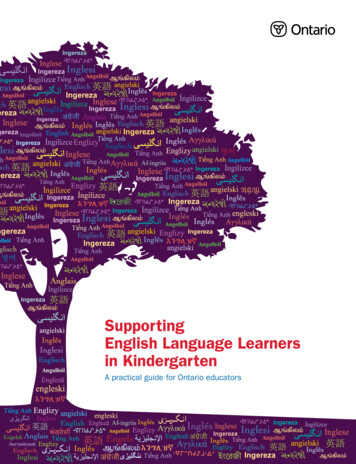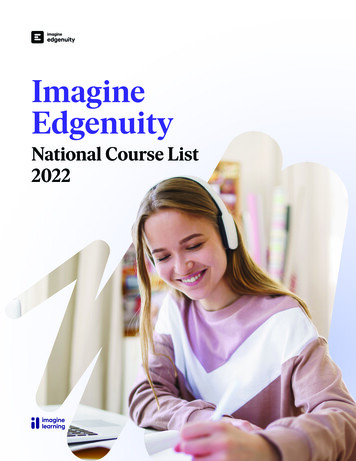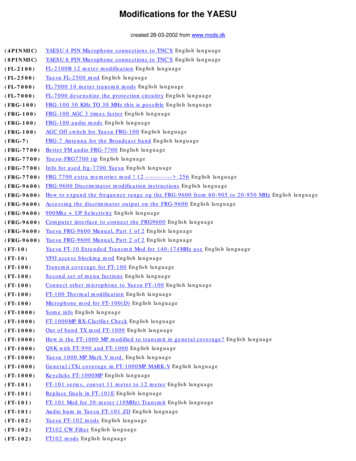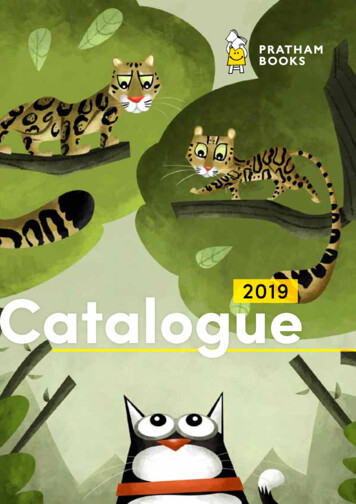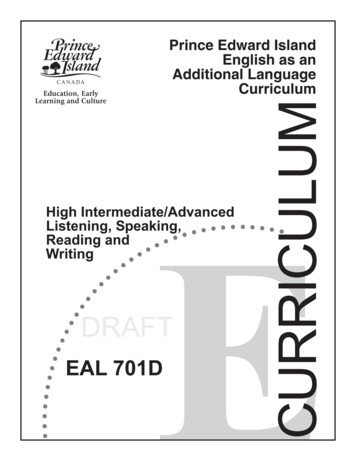
Transcription
FOUNDATIONS PAPERImagine Edgenuity:Supporting EnglishLanguage Learners1Imagine Edgenuity: Supporting English Language Learners
The Growing ConcernDuring the 2018–19 school year, approximately 5.0 million U.S. public school students wereidentified as English language learners (ELLs).¹ While ELLs comprise approximately 10 percentof the K–12 population, experts predict this figure will reach 40 percent by 2030.2ELLs face unique academic challenges. As a group, they speak more than 400 languages,³ and11.2 percent receive special education services.4 ELLs not only have to learn the fundamentals ofa new language, but they also must meet the new rigorous requirements of the Common CoreState Standards initiative and other college and career readiness state standards.At a time when ELLs are expected to master more advanced content and concepts than everbefore, data indicate that ELLs are struggling in U.S. schools. Among eighth graders, only 4 percentof ELL students achieved proficiency on the reading portion of the 2019 National Assessmentof Educational Progress (NAEP), compared to 36 percent of non-ELLs.5 Similarly, only 5 percentof ELL eighth graders achieved proficiency on the mathematics portion, while 36 percent ofnon-ELLs accomplished this.6
Researchers have pinpointed several evidence-based instructional strategies for improving theacademic achievement of ELLs.7,8,9 The following principles are incorporated into Edgenuity courses:1. PROVIDE MULTIPLE EXPOSURES TO VOCABULARY.Research indicates that “front-loading” or preteaching vocabulary before a lesson helps makecontent more accessible to students.10 Studies also show that vocabulary development is enhancedwhen students receive multiple exposures to words.11Our solution: At the beginning of each lesson, Edgenuity students are explicitly taught fourto six academic and domain-specific vocabulary words. Students have chances to practiceusing and applying these words through the course. They also have access to the Edgenuityglossary tool, which enables them to track their understanding of vocabulary words.2. SET HIGH EXPECTATIONS.Studies indicate that ELLs are often held to lower benchmarks for academic achievement thantheir non-ELL peers.12 All too often, teachers tend to water down the curricula and do not teachhigher-order thinking skills.13Our solution: Higher-order thinking skills such as analysis, evaluation, and application areembedded throughout each course. In reading assignments, students learn to analyze textclosely. Writing assignments require students to support a position using evidence fromprimary and secondary sources. In mathematics, students solve multi-step problems andjustify their thinking. Interactive and open-ended activities leverage technology to enablestudents to make and test predictions and build conceptual understanding. Students alsoengage in projects and performance tasks designed to build higherlevel skills in all areasand apply learning in authentic contexts. Finally, Edgenuity’s discussion board enablesstudents to collaborate in a teacher-guided and-monitored forum that elicits academicdiscourse and critical thought.3. PROVIDE EXPLICIT INSTRUCTION.Explicit instruction includes setting clear learning goals, modeling how to complete a task,providing multiple opportunities for students to practice skills independently, and showingrelationships between concepts, words, and ideas. Studies indicate that explicit instruction canimprove ELLs’ comprehension.14Our solution: Explicit instruction is the cornerstone of Edgenuity courses. Our coursesfeature videos of highly qualified, certified instructors who deliver explicit instruction,orient students to the lesson goals, ground concepts in relevant real-world contexts, andoffer clear and concise explanations of subject matter.2Imagine Edgenuity: Supporting English Language Learners
4. ACTIVATE BACKGROUND KNOWLEDGE.Data show that ELLs vary in age, socioeconomic status, school exposure, backgroundknowledge, life experiences, and culture.15 Studies indicate that effective ELL instructionbuilds upon students’ existing knowledge to make content meaningful.16Our solution: Throughout our courses, Edgenuity activates students’ background knowledge.The warm-up at the beginning of the lesson connects students’ prior knowledge to newcontent. Direct-instruction videos emphasize the real-world context and relevance of thesubject matter. On-screen teachers also prompt students to think about what they alreadyknow when learning new topics.5. MAKE INSTRUCTION ACCESSIBLE.Research shows that universally accessible instruction can anticipate and accommodate theneeds of ELLs with diverse backgrounds by proving multiple means of expression, representation,and engagement.17 In addition, studies show that graphic organizers can help make relationshipsbetween concepts and skills apparent to students.18Our solution: Edgenuity courses provide students with multiple means of representation,expression, and engagement.Multiple Means of Representation:Multiple Means of Expression:Edgenuity courses use video lectures, graphicThroughout instruction and assessments,displays, text, simulations, video captioning, andstudents manipulate images, answer questions,read-aloud support features. Onscreen teachershighlight text, complete surveys, and fill outexplain concepts using verbal, manipulative,graphic organizers. These multiple means ofconcrete, numerical, graphical, and symbolicexpression appeal to a variety of learning stylesrepresentations. Graphic organizers are includedand encourage students to demonstrate theirin instruction, tasks, and assignments.knowledge in a variety of ways.Multiple Means of Engagement:Detailed course maps and pacing guides clearly state expectations, provide students with a structuredoverview of course activities and objectives, and visually alert students and teachers to students’ courseprogress and pace. Teachers can personalize instruction based on an individual student’s needs. Prior toinstruction, teachers can create individualized tutoring modules by customizing targeted supplementallearning blocks. At the end of instruction, teachers can adjust the time allotted for assessments, allowstudents to use a calculator or dictionary, or modify grading settings.3Imagine Edgenuity: Supporting English Language Learners
6. USE HOME LANGUAGE STRATEGICALLY.Studies show that students can better understand complex concepts if they are explained intheir home language.19Our solution: Students can translate on-screen text into Amharic, Arabic, Armenian,Bengali, Bosnian, Chinese, Croatian, Czech, Danish, Dutch, Estonian, Filipino (Tagalog),Finnish, French, German, Greek, Gujarati, Haitian Creole, Hebrew, Hindi, Hmong, Hungarian,Indonesian, Italian, Japanese, Javanese, Kazakh, Korean, Kurdish, Lao, Latvian, Lithuanian,Malayalam, Maori, Marathi, Nepali, Norwegian, Pashto, Persian (Farsi), Polish, Portuguese,Punjabi, Romanian, Russian, Samoan, Serbian, Shona, Sinhala, Slovak, Slovenian, Somali,Spanish, Swahili, Swedish, Tamil, Telugu, Thai, Turkish, Ukrainian, Urdu, Vietnamese, andYoruba for auditory comprehension. By using the translation feature, students can check foraccurate reading comprehension.7. MODEL METACOGNITIVE STRATEGIES.Studies show that metacognitive strategy instruction—or helping students to “think abouttheir thinking”—can enhance ELLs’ academic achievement. In particular, strategies such asplanning and goal setting, asking questions, making predictions, monitoring comprehension,problem solving, and evaluating can help improve ELL students’ declarative, procedural, andconditional knowledge.20Our solution: Edgenuity provides problem-solving, metacognitive, and reading-strategyinstruction. Students are taught a multi-step process for solving problems. They learn howto use mnemonics, graphic organizers, checklists, and problem-solving strategies to check,process, and retrieve information. They also are taught comprehension strategies such asmaking connections, predicting, visualizing, asking questions, monitoring understanding,making inferences, analyzing text structure, and synthesizing. Edgenuity courses encouragestudent elaboration, self-questioning, and explanation.8. PROVIDE INSTRUCTIONAL SUPPORT FOR THE CLOSE READING OF TEXTS.Experts agree that close reading of text is essential for ELLs who need to acquire academiclanguage.21Our solution: Edgenuity’s CloseReader leverages the power of technology to model,scaffold, and reinforce close reading of text. The CloseReader models fluent and expressivereading at strategic points in the text. Text and audio reading supports scaffold thoughtfulanalysis of individual words, phrases, and sentences as students read. The CloseReaderalso features embedded comprehension tasks, ensuring that students think critically asthey read—not just after they read.4Imagine Edgenuity: Supporting English Language Learners
Endnotes1. Irwin, V., Zhang, J., Wang, X., Hein, S., Wang, K., Roberts, A., York, C., Barmer, A., Bullock Mann, F., Dilig, R., and Parker, S. (2021). Reporton the Condition of Education 2021 (NCES 2021-144). U.S. Department of Education. Washington, DC: National Center for EducationStatistics. Retrieved May 10, 2022 from https://nces.ed.gov/pubsearch/pubsinfo. asp?pubid 2021144.2. Thomas, W., & Collier, V. P. (2002). A national study of school effectiveness for language minority students’ long-term academicachievement. Santa Cruz, CA: Center for Research on Education, Diversity, & Excellence. Retrieved 12/18/12 from asComplete.pdf.3. National Clearinghouse for English Language Acquisition. (2021). English Learners and Critical Languages. Retrieved May 10, 2022 fromhttps://ncela.ed.gov/files/fast df.5. National Clearinghouse for English Language Acquisition. (2021). English Learners with Disabilities. Retrieved May 10, 2022 from https://ncela.ed.gov/files/fast .5. U.S. Department of Education. Institute of Education Sciences, National Center for Education Statistics, National Assessment ofEducational Progress (NAEP), 2019 Reading Assessment.6. U.S. Department of Education. Institute of Education Sciences, National Center for Education Statistics, National Assessment ofEducational Progress (NAEP), 2019 Mathematics Assessment.7. Alliance For Excellent Education. (2012). The role of language and literacy in college- and career-ready standards:Rethinking policy and practice in support of English language learners. Retrieved 12/17/2012 from rdsELLs.pdf.8. Gersten, R., Baker, S. (2000). What we know about effective instructional practices for English-language learners. Exceptional Children,66(4),454-4709. Li, J. (2012). Principles of effective English language learner pedagogy. New York, NY: CollegeBoard. Retrieved 12/17/12 from ective-englishlanguage-learner-pedagogy.pdf.10. Beck, I. L., McKeown, M. G., & Kucan, L. (2002). Bringing words to life: Robust vocabulary instruction. New York: Guilford.11. August, D., Carlo, M., Dressler, C., & Snow, C. (2005). The critical role of vocabulary development for English language learners. LearningDisabilities Research & Practice, 20(1), 50–57.12. Li, J. (2012). Principles of effective English language learner pedagogy. New York: CollegeBoard. Retrieved 12/17/12 from ective-english-language-learner-pedagogy.pdf.13. Koelsch, N. (2006). Improving literacy outcomes for English language learners in high school. Washington, D.C.: National High SchoolCenter. Retrieved 12/17/12 from http://www.betterhighschools.org/docs/NHSC Adolescents 110806.pdf.14. August, D., & Hakuta, K. (Eds.) (1997). Improving schooling for language-minority students: A research agenda. Washington, D.C.:National Academy Press, 171.15. Alliance For Excellent Education. (2012). The role of language and literacy in college- and career-ready standards:Rethinking policy and practice in support of English language learners. Retrieved 12/17/2012 from ardsELLs.pdf.16. Short, D., & Fitzsimmons, S. (2007). Double the work: Challenges and solutions to acquiring language and academic literacy foradolescent English language learners – A report to Carnegie Corporation of New York. New York: Carnegie Corporation. Retrieved8/30/12 from http://www.all4ed.org/files/DoubleWork.pdf.17. CAST. (2011). Universal design for learning guidelines, Version 2.0. Wakefield, MA: CAST.18. Janzen, J. (2008). Teaching English language learners in the content areas. Review of Educational Research, 78 (4), 1010–1038.19. Short, D., & Fitzsimmons, S. (2007). Double the work: Challenges and solutions to acquiring language and academic literacy foradolescent English language learners – A Report to Carnegie Corporation of New York. New York: Carnegie Corporation. Retrieved8/30/12 from http://www.all4ed.org/files/DoubleWork.pdf.20. Alliance for Excellent Education. (2007). Urgent but overlooked: The literary crisis among adolescent English language learners.Retrieved 8/30/12 from http://www.all4ed.org/files/UrgentOver.pdf.21. Alliance for Excellent Education. (2012). The role of language and literacy in college- and career-ready standards: Rethinking policy andpractice in support of English language learners. Retrieved 12/17/12 from ardsELLs.pdf.5Imagine Edgenuity: Supporting English Language Learners
imaginelearning.com877-338-2020 solutions@imaginelearning.com6Imagine Edgenuity: Supporting English Language Learners896574455 2205
At a time when ELLs are expected to master more advanced content and concepts than ever . ELLs are struggling in U.S. schools. Among eighth graders, only 4 percent of ELL students achieved proficiency on the reading portion of the 2019 National Assessment of Educational Progress (NAEP), compared to 36 percent of non-ELLs.5 Similarly, only 5 .
